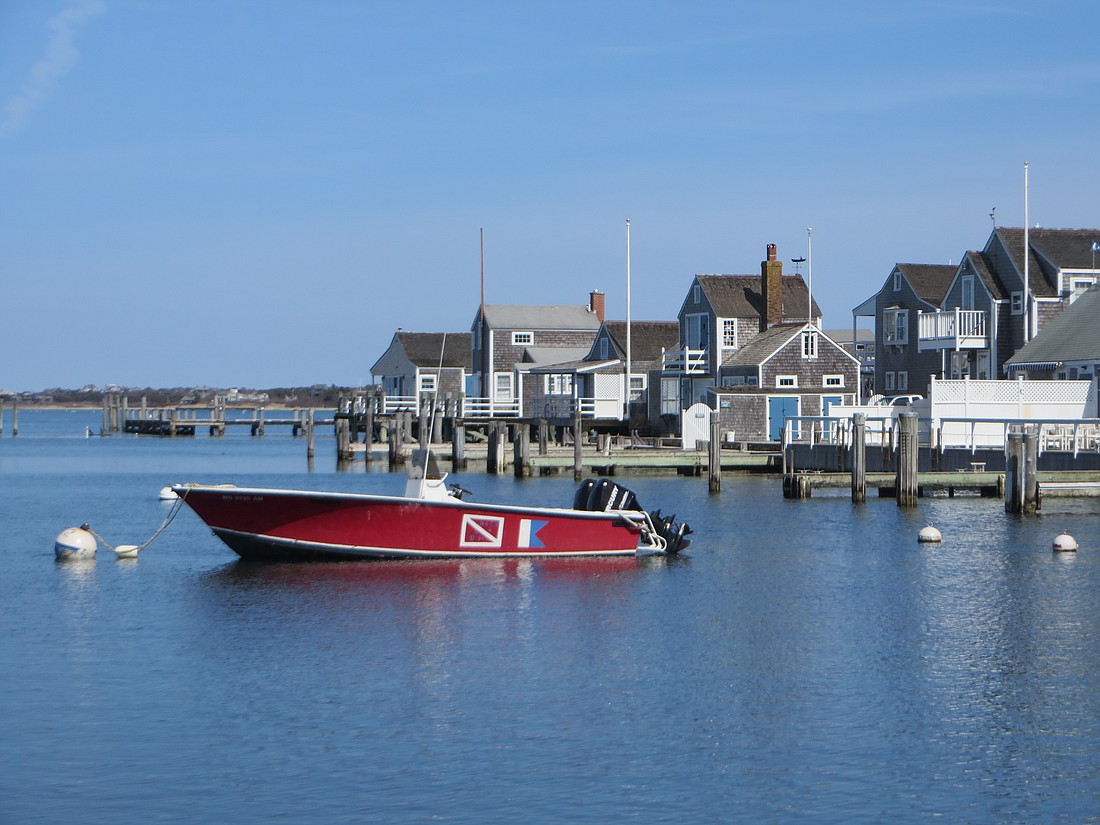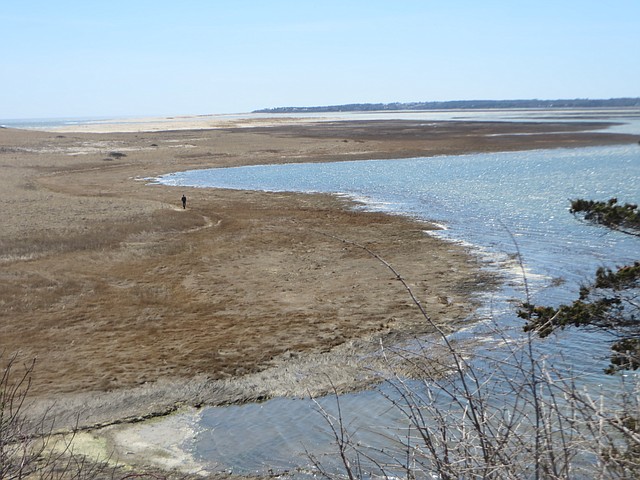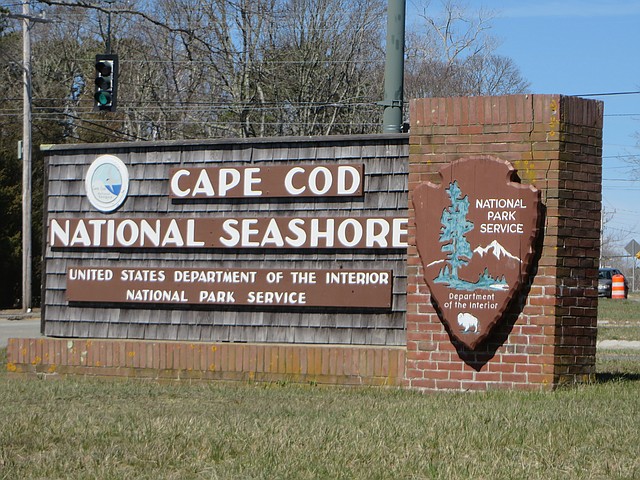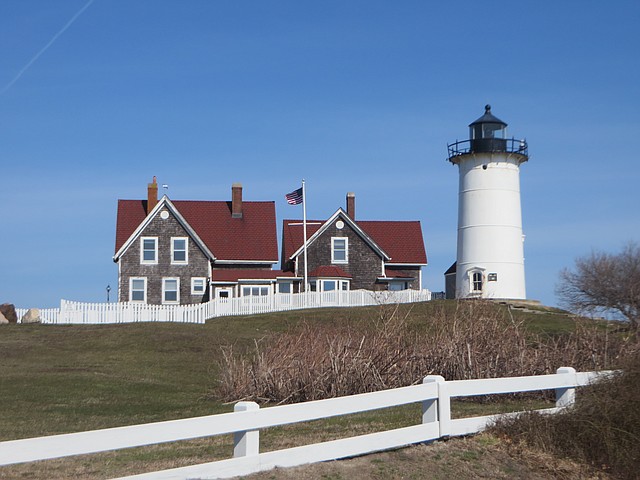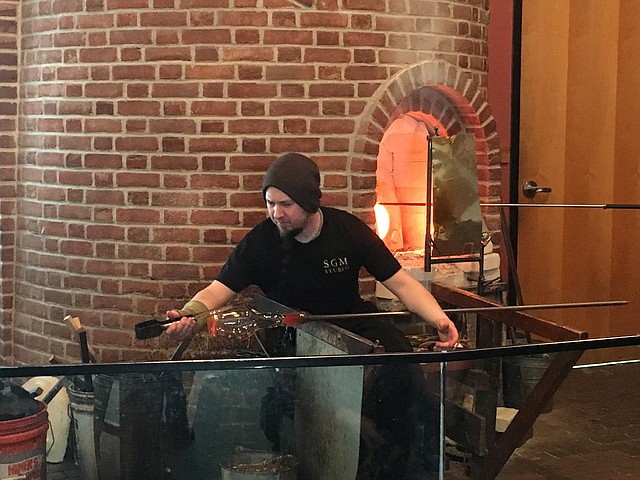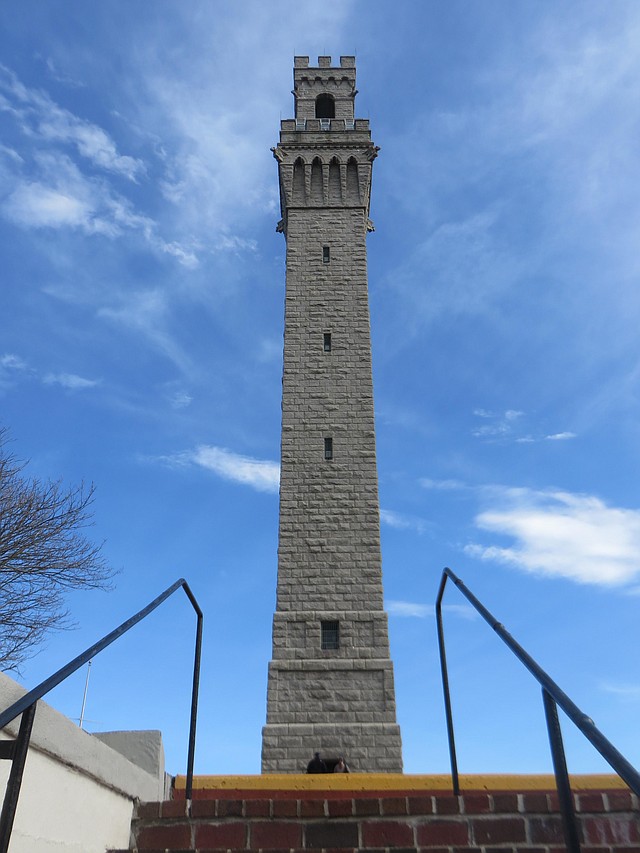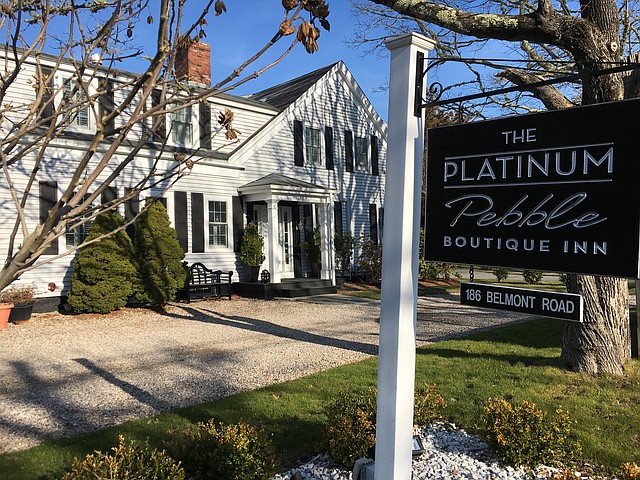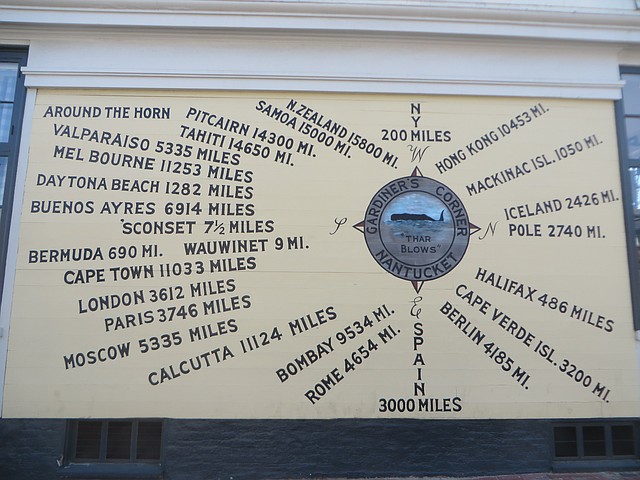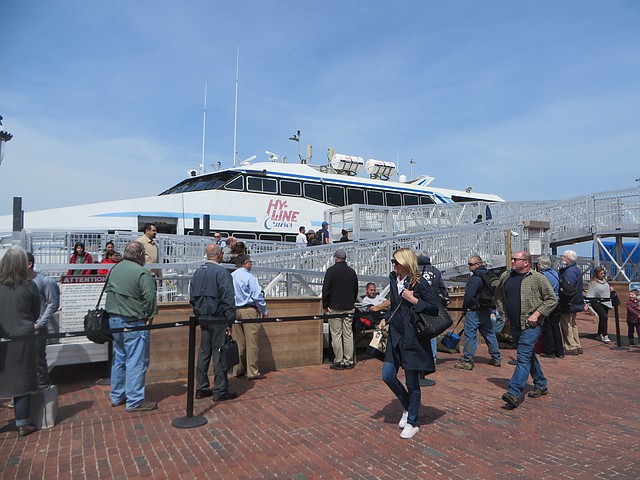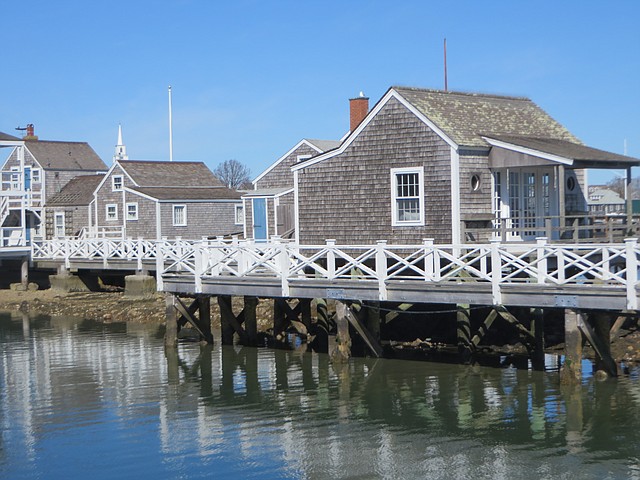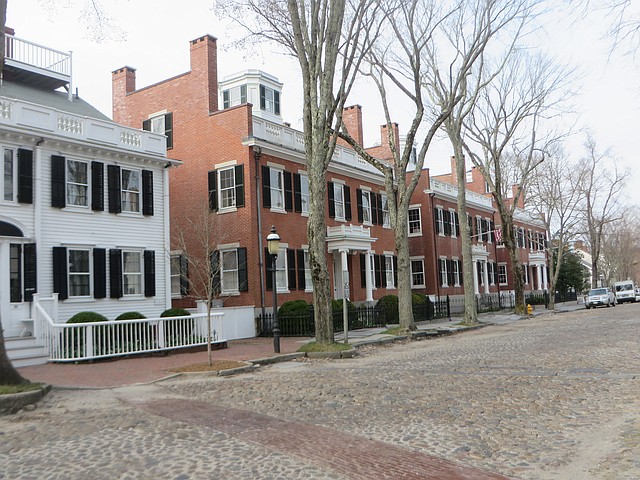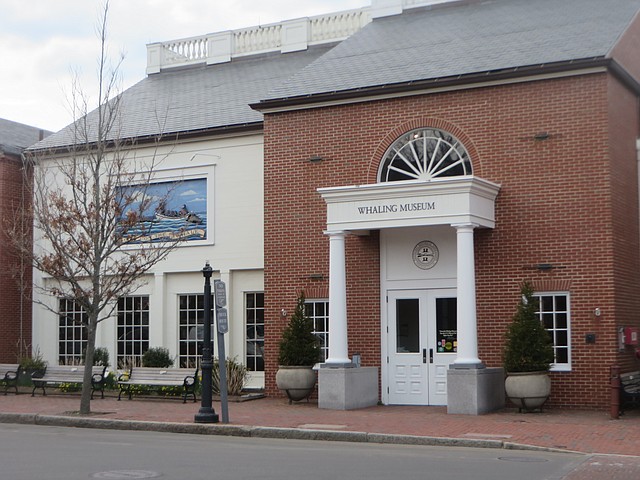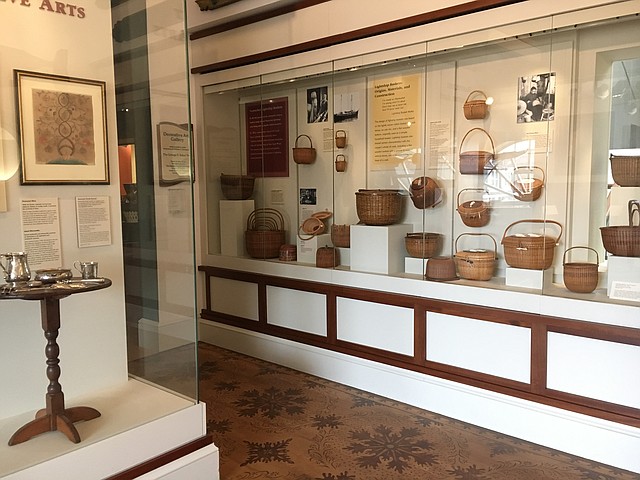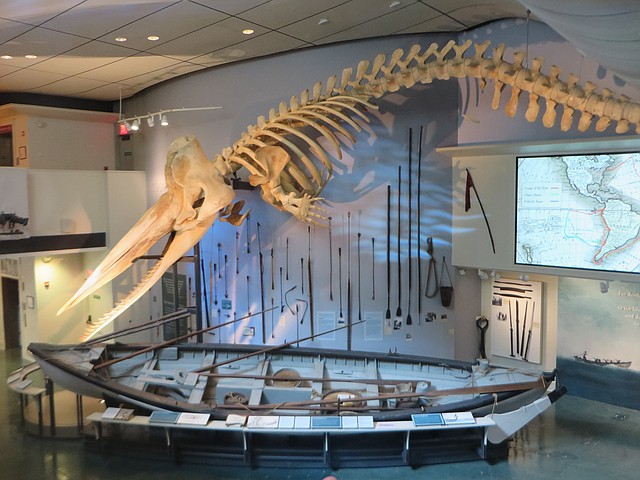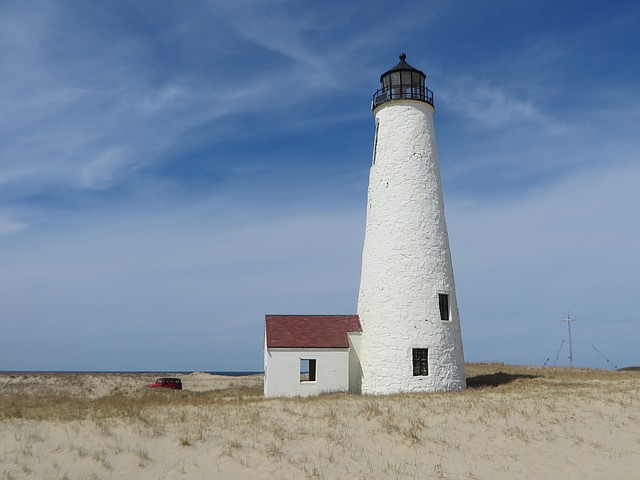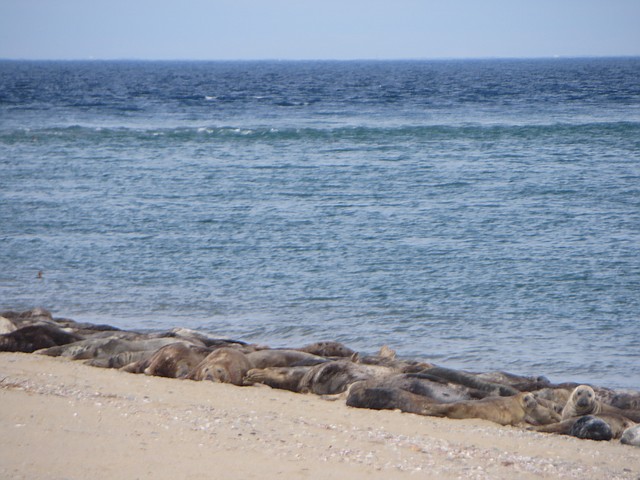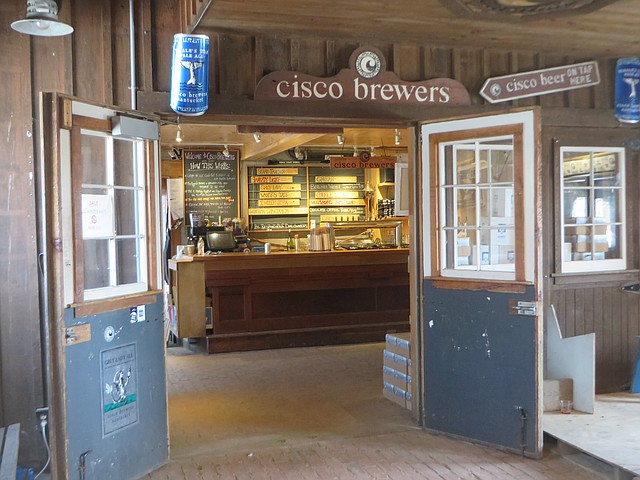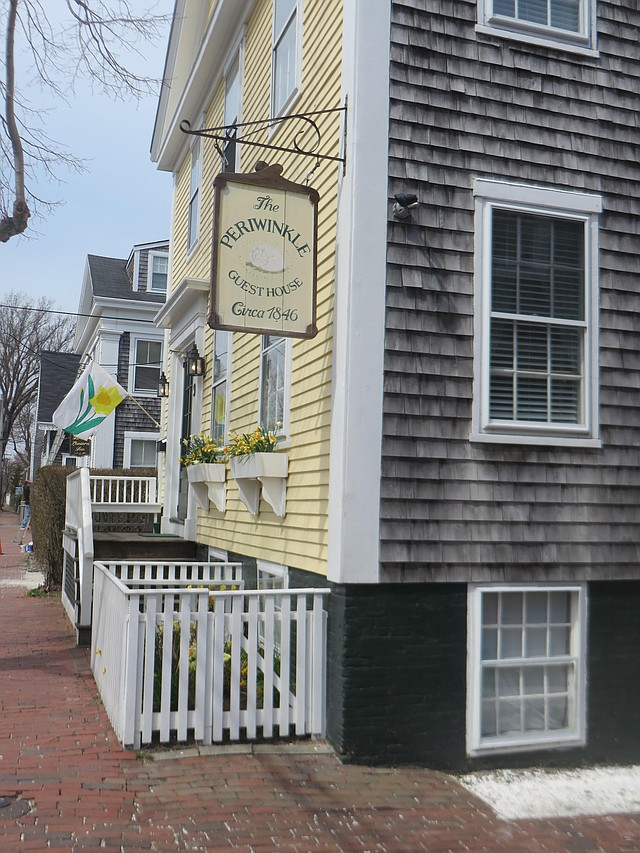The allure of off-season on Cape Cod and Nantucket
May 22, 2017 at 6:00 a.m.
There’s nothing like strolling on a pristine ocean beach with nary a soul in sight and only the occasional gull or plover to share the space. Far off in the distance, a pair of whales spout, while nearby, several seals play peekaboo in the water. The air is fresh and crisp, and Mother Nature’s good mood means ample sunshine. It’s April on Cape Cod and the crowds have yet to make their way to this captivating destination. Come Memorial Day, however, they will be here en masse, staking claim to their spots in the sand, lining up at the lobster shacks and fudge shops and creating traffic jams along the roadways of this famed locale.
Spring on Cape Cod is a magical time, as that’s when everything begins to awaken. Flowers start to bloom, while preparations are in process for the upcoming summer season. Workmen make their presence known as they ready hotels and other businesses in advance of the hordes of visitors that will soon descend on the area. But, there’s still a sleepy quality to the place, with the majority of attractions closed or “shut” as the signs indicate. To some, this particular reality may be a downside. Others, though, might view it as an opportunity to leisurely explore one of the country’s most beautiful vacation spots with plenty of elbow room to spare.
Geographically, Cape Cod is situated at the extreme southeast corner of Massachusetts. Originally a peninsula, it became a man-made island after the Cape Cod Canal was built in 1914. The history of this area dates back 10,000 years ago, when the earliest inhabitants arrived. Native Americans, the Wampanoag in particular, populated the region prior to the Pilgrims making their appearance in 1620. The Pilgrims came aboard the Mayflower and sailed into Provincetown Harbor on the hooked tip of the Cape after a difficult trans-Atlantic voyage. Before going ashore, they executed the Mayflower Compact, which committed all male passengers to pledge to cooperate in the new government. The ship then left Cape Cod and proceeded to Plymouth, where the first colony was established. As the colony grew, some individuals decided to move to the Cape, where they farmed and fished for their livelihood. English explorer Bartholomew Gosnold is credited with coining the name of the area after he visited its shores in 1602 and took aboard a “great store of codfish” from the peninsula’s surrounding waters.
Cape Cod is approximately seventy miles long from the Canal to Provincetown’s Race Point on the outer tip of the island. It encompasses a total of 399 square miles and is from one to twenty miles wide. There are fifteen towns on the Cape, which are divided into three sections: Upper, Mid and Lower Cape. The area is easily accessible by car from Boston and other New England metro areas. Additionally, there are regularly scheduled flights to the Cape from major airports in Boston and Providence. Though relatively close to several metropolitan hubs, the island possesses a feeling of being “world’s away” from urban existence.
The Cape boasts some impressive statistics including 586 miles of seashore, 13 lighthouses, 115 beaches, 106 miles of bike paths, 83 museums, 321 hotels, 2,254 shops and over a thousand restaurants. Beaches remain the most popular of destinations for visitors and the options are many, from popular Sandy Neck in Barnstable to Race Point and Herring Cove in Provincetown. Some, like Town Beach in Sandwich, are accessed via a boardwalk that is built over low dunes and a creek. As you stroll the walkway, you’ll notice that the planks are engraved with names and special messages. After Hurricane Bob destroyed the initial boardwalk in 1991, residents and business owners purchased new planks to rebuild it.
For those seeking the wild, untamed coastline, Cape Cod National Seashore is a must. Henry David Thoreau, who traced the coast of the Atlantic Ocean in Massachusetts back in the 1800s, wrote of the area, “A man may stand there and put all America behind him.” Begin your visit with an orientation at the Salt Pond Visitor Center, which offers an outstanding museum with exhibits that showcase the Outer Cape’s location in the Gulf of Maine ecosystem and Wampanoag culture and history. You’ll be treated to lovely views of Salt Pond, Nauset March and the Atlantic, while learning about the best hiking trails, beaches, scenic routes and overlooks within this forty-mile sanctuary. The landscape is diverse, consisting of marshes, ponds, sandy beaches, uplands and wild cranberry bogs. There are also several historic buildings, including lighthouses, cottages and even an old life-saving station.
Lighthouses have played a major role in the history of the island. Highland Light in Truro was the first to be erected back in 1798 and served as a beacon for voyagers coming from Europe to Boston. The present brick structure dates from 1857 and is perched high along windswept bluffs overlooking the Atlantic. Don’t be surprised if you see golfers in the vicinity, as Highland Links, one of the Cape’s oldest courses, is located nearby. The place has seen more than a hundred years of golf and boasts a heritage that’s aligned with the genuine links of the Scottish tradition. The course is comprised of deep natural rough, Scotch broom and heath, and has spectacular ocean views, though the conditions are known to be quite windy.
Each of the lighthouses on the Cape has its own quintessential New England flavor. My personal favorites include picture-pretty Chatham Light, which is on Coast Guard property in the town of Chatham; Nauset Light in Eastham, famous for being the lighthouse featured on the Cape Cod Potato Chips bag; and Nobska Light in Woods Hole. The latter is a photographer’s dream, as the setting is incredibly beautiful and romantic. Poised on a hilltop overlooking Vineyards Sound and Martha’s Vineyard, this extraordinary location offers epic sunsets.
Visitors to the island might be surprised to learn that it is a cultural mecca. Artists, actors and writers have been coming to the Cape for years, inspired by its dramatic landscape. There are year-round festivals celebrating the arts, as islanders embrace creativity in all forms. Galleries abound, as do museums, where the offerings range from the esteemed Woods Hole Oceanographic Institute and the Cahoon Museum of American Art to the Mashpee Wampanoag Indian Museum and the Heritage Museums and Gardens. Some of these institutions might not be open in the off-season, so it’s always good to check websites for accurate information. Of special note is the Sandwich Glass Museum with its extensive collection of the various types of glassware produced in Sandwich by the well-known Boston & Sandwich Glass Company in the 1800s. Daily glassblowing demonstrations are given on-site.
One of the most popular attractions on the Cape is the JFK Hyannis Museum and corresponding Kennedy Memorial. People flock to Hyannis to pay homage to our 35th president, who spent many idyllic times sailing in the ocean near his summer home in Hyannis Port. The monument, which is adorned with Kennedy’s image, looks over Lewis Bay. A small garden and fountain provide space for reflection. The museum is dedicated to preserving and promoting the legacy of JFK, his family and their deep connection to the Cape. Through a series of engaging multi-media displays and numerous photos, visitors are able to gain greater insight into Kennedy’s private and public life. The newest exhibit, “JFK at 100: Life and Legacy,” tells the story of our fallen president from his childhood through Election Day and beyond into the White House. Among the displays are rarely seen photos of Kennedy and his wife Jackie, along with other family members, as well as pictures of life at the Kennedy Compound, often known as the Summer White House.
Also in Hyannis is the Cape Cod Potato Chips factory, where you can take a self-guided tour to learn about the process of making these tasty snacks. The company is a success story that has brought additional fame to the Cape. Its chips are known for being kettle-cooked and thicker-than-normal in consistency. And of course, free samples are provided at the end of the tour.
Culture is also prominent in the region’s architecture, with many homes built in the recognizable Cape Cod style, which traces its origins to Colonial New England. I experienced house envy, as I oohed and aahed at these beauties with their steeply pitched roofs, end gables, double dormers and weathered cedar shake shingles. And then there are the numerous historical monuments, colonial courthouses and 18th and 19th century churches and meetinghouses that dot the island. As you drive around, you’ll begin to notice that these handsome edifices are prolific in each town. One after another, they appear as sentinels or guardians of the past. They are among some of the most photogenic buildings you’ll ever see. A few, like the Pilgrim Monument in Provincetown and Scargo Tower in Dennis, offer great views of the surrounding areas. As you trudge up the seemingly never-ending stairs of the Pilgrim Monument, know that the reward is definitely worth the climb!
Such physical exertion demands sustenance. Be assured you won’t go hungry on the Cape. There’s something to appeal to everyone’s palette and budget. Seafood, however, reigns supreme. I ate my fill and then some of fresh fish, clams, shrimp and lobster. The latter appeared in so many different forms including rolls, bisque, salads, pasta, quesadillas, melts and more, that I stopped counting. You’ll also be tempted to stop at the homemade fudge and ice creameries, which are abundant on the island. Indulge yourself. You won’t be disappointed.
When it comes to accommodations, the Cape has more than 19,000 guest rooms available. The options are extensive, from small B&Bs and intimate country inns to full-service resorts. I planted myself at the centrally-situated Platinum Pebble Boutique Inn in Harwich during my stay. This adults-only, upscale, yet surprisingly affordable property, is rated as one of the top inns on the Cape and it exceeded my expectations on every level. The place is located in the heart of the island on a quiet residential street within walking distance to the beach, several conservation areas and the Cape Cod Rail Trail (a great multi-user trail that extends 32 miles from Harwich to Wellfleet). It’s also close to Herring River, a prime spot for kayaking. The inn is artfully designed in a chic, contemporary style with clean lines and soothing tones. Rooms are ample in size with expansive walk-around showers, comfy beds and lovely linens. They’re blessedly free of knick-knacks and potpourri. Outside, there’s a swimming pool, outdoor fireplace and perennial garden.
Owners Stephanie and Mike Hogan are terrific hosts, who genuinely care about their guests. They are incredibly helpful, offering advice, suggestions and recommendations about activities and attractions on the island. They will also make dinner reservations for you at any one of the numerous restaurants in the area. And Steph, a real foodie, whips up delightful gourmet breakfasts each morning that you can choose to have served in your room, the lounge or on the patio by the pool. One morning it was bacon-wrapped asparagus, poached eggs and a fruit parfait with yogurt and homemade granola. Another time it was Belgian waffles with whipped lemon ricotta. On my last day at the inn, Steph made it even harder for me to leave after I consumed her eggs Benedict and sweet potato hash.
Next stop – Nantucket Island. Known as the “faraway land” or “the Grey Lady,” this enchanting enclave, thirty miles out to sea, has been the recipient of numerous accolades over the years, including “Best Island in the World” by National Geographic. It’s a magical place with a legendary status that attracts visitors from all parts of the globe, many who return year after year. Whether you’re a nature lover, history buff, art aficionado or sports enthusiast, there’s something for everyone on Nantucket.
Reaching the island takes a bit of effort, but the journey is part of the experience. You can only get there by sea or air, as there are no land routes, bridges or tunnels connecting the island to the mainland. The majority of visitors don’t bring their cars because having one on Nantucket is more of an inconvenience than an asset. It’s also costly to put your vehicle on the car ferries. Hy-Line Cruises operates a high-speed catamaran passenger-only ferry year round between Hyannis on Cape Cod and Nantucket. The trip takes an hour and it’s a great way to relax and get into an “island time” mode, while enjoying the scenery.
As you come into the harbor, all of your preconceived notions of Nantucket, will instantly become reality. The place is everything you imagined it to be, from the classic weathered grey shingled cottages to the quaint cobblestone streets lined with eclectic shops and eateries. This pocket-sized island, which measures about fourteen miles long and three and a half miles wide, is devoid of traffic lights, fast food restaurant chains and neon signs. Approximately 10,000 residents make their home here year-round, but during the summer months this number skyrockets to 60,000. This is reason enough to come in the off-season, when you’ll have the place pretty much to yourself.
The island is ideal for cyclists, as there are more than 29 miles of bike and multi-user paths, as well as miles of roadways to explore on two wheels. And the bike shops in town are stocked with rentals, so no need to haul your equipment with you on the ferry. Many attractions are located within the main hub of the island and thus also accessible on foot. Head to the visitors center for orientation information and make sure to pick up the self-guided historic walking tour.
Nantucket is fortunate to have preserved some of the finest 18th and early 19th century architecture in the country. It’s a remarkably intact town where more than 800 houses built before the Civil War still stand. Due to its architectural integrity, the historic core was designated a National Historic Landmark in 1966 and subsequently extended to the entire island in 1971. As you wander about, you’ll see a variety of architectural styles including early lean-to houses, Federal and Greek Revival mansions with classical porticos, Victorian homes with gingerbread elements, and of course, the typical Nantucket House with a four-bay façade and central chimney. Many of the stately residential buildings on Main Street date from the 1820s, 30s and 40s, and were constructed by wealthy families during Nantucket’s economic peak.
Some historical properties of note in town include the Old Mill, which has the distinction of being the oldest continuously operating windmill in the country; Quaker Meeting House, the last of its kind to survive on the island; Old Gaol, the town’s penal facility until 1933; Oldest House, the sole surviving structure from the island’s original 17th century English settlement; African Meeting House, one of the oldest Black church buildings in the nation; and the Fire Hose Cart House. The latter was built forty years after the Great Fire of 1846 destroyed much of downtown Nantucket to serve as a reminder of the pivotal role fire played in the island’s history. This catastrophic incident propelled an already declining economy to hit bottom and eventually cause the demise of Nantucket’s whaling industry. Decades of hardship followed until the island began to reinvent itself as a tourist destination.
There are a number of small museums on the island with niches that explore the natural sciences, ecology and marine life, astronomy, the art of Nantucket’s famed lightship baskets, shipwreck and lifesaving efforts, and more. The Nantucket Whaling Museum, however, takes center stage. Housed in what was once a spermaceti candle factory, the museum provides fascinating insight into the island’s century-long reign as Whaling Capital of the World. It features top-quality exhibits with galleries devoted to scrimshaw art, decorative arts, trading souvenirs from Asia and the South Pacific, portraits of whaling captains and wealthy merchants and a restored 1847 candle factory.
The museum’s collection of scrimshaw is considered one of the most important of its kind. Highlights include some of the earliest and rarest sperm whale teeth engraved by famous scrimshaw artists, as well as specimens of tools, coconut-shell dippers, furniture, boxes and more. In the decorative arts gallery, you’ll discover a wonderful collection of lightship baskets and framed needlework pieces. Original Nantucket lightship baskets were made from tightly woven rattan with sturdy wooden bottoms and swinging handles, designed to tote anything from food to firewood. Sailors on whaling ships would make them to while away the long hours of boredom at sea and then often give them to their wives left on shore. In the souvenir gallery, you’ll find such items as a Hawaiian tribal necklace made of whale tooth and hair, a warrior’s sharkskin body armor and a rare model of a Maori war canoe. An integral component of the museum is the 1847 spermaceti-candle factory with its two-story beam press, the only original beam press still in place in the world, along with the foundation of the oil-processing tryworks.
The most dramatic object in the museum, however, is a 46-foot sperm whale skeleton that dives from the ceiling, mouth open, teeth menacing. Being this close to such an articulation is breathtaking. It’s almost as if the whale is an animated being- swimming, twisting and turning its head, flipping its tail - while eyeing you, the human, not the other way around. The skeleton is from a bull whale that died in 1998, after floundering for two days in the surf off the eastern end of the island.
This excellent museum also offers several programs for visitors. Take time to watch the signature “Nantucket” film by award-winning documentary filmmaker Ric Burns or listen to a storyteller present the tale of the ill-fated Nantucket whaleship Essex, which was sunk in the Pacific in 1820 after being attacked by a sperm whale. This was the story that inspired Herman Melville’s Moby Dick. And before you leave, check out the rooftop observation deck. Positioned to see all of the harbor and much of the town, it offers spectacular views of the island. From this perch, it’s easy to imagine Nantucket as a thriving, bustling whaling port.
History is a major draw on the island, but its beaches are also prime attractions. Nantucket boasts more than 82 miles of some of the finest beaches in the northeastern U.S. Those on the north side of the island, like Brant Point, Jetties and Steps, are generally calmer than those located on the south end because they are protected by Nantucket Sound and have fewer waves. On some of the beaches, you can drive a vehicle, as long as you have a permit. One of the popular activities is to rent a jeep for the day and go out to Great Point, on the extreme northwest tip of the island. This is a ruggedly beautiful coastal environment with windswept dunes, tidal ponds and marsh grasses. The area provides multiple habitats for an array of coastal plant and animal species. Driving on sand can be tricky, though, so it’s best to heed the instructions about tire pressure because if you get stuck, the tow fee is steep.
After about seven miles of driving on the beach, you’ll reach Great Point Light. The setting is stunning and remarkably serene, especially in the off-season. It might surprise you, however, to realize that the rocks you thought you saw from a distance are actually seals. This is a well-known basking spot for these creatures and they are everywhere. Pups frolic in the water, while moms vigilantly watch them. Further down the beach the large males or bulls lounge indolently. Look for the horseshoe crabs that skitter in the sand and gaze at the shorebirds that skim the waves. This is nirvana.
Another nice outing is to visit the wee village of Siasconset or ‘Sconset as the locals call it, on the southwestern side of the island. Getting there involves a pleasant seven mile bike ride from town on a dedicated path. You’ll know you’ve arrived when you reach a roundabout, where there’s a small post office and a few shops. The exertion demands a treat, so head into the Siasconset Market for an ice cream cone or sandwich made to order. Take a walk or ride around the area, which is mostly residential, consisting of typical Nantucket style houses and smaller low-roofed bungalows. Some of these dwellings are over two centuries old. Many, like a number of homes on the island, are identified by their names, such as The Beehive, Woodbox, Little Miss Dreamer and Captain’s House, as opposed to their addresses. This is common practice on the island and it’s fun to read off the various habitation epithets as you roam the area.
Like Cape Cod, Nantucket shines in the culinary arena with plentiful offerings from the sea, including its renowned Nantucket Bay Scallops. The island’s chefs take pride in incorporating fresh, seasonal ingredients in their innovative dishes, creating palette-pleasing, fork-to-table meals. Restaurants run the gamut from high end fine dining establishments with to-die-for views to casual eateries where you can kick back and enjoy the local color. In the off-season, there are fewer options available, but it’s never a problem finding good food.
When it comes to libations, the island’s triumvirate of Nantucket Vineyard, Triple Eight Distillery and Cisco Brewers has you covered. Better yet, you can taste and sample any of these offerings in just one location. It’s a triple threat, guaranteed to please any kind of drinker, any kind of taste. You’ll find locals and visitors alike mingling at the picnic tables inside the big white tent, or on the back deck, as they imbibe in a glass of Peach Pinot Gris, Cranberry Vodka or Whale’s Tale Pale Ale, while listening to live music.
There’s a wide array of lodging options on the island, including cozy B&Bs, distinctive inns, grand old hotels, full-service resorts and cottages set amidst rural landscapes. Most of the properties are located within the main town. Many are historic homes that have been impeccably restored, such as the Periwinkle Guest House, where I stayed during my visit. This Greek Revival style house, circa 1846, is located in an area historically known as “Guest House Row.” It’s conveniently located and within walking distance to the ferries, downtown shopping, restaurants, beaches and the Whaling Museum. Rooms, some with king and queen size four-posted canopy beds, offer views of the harbor, gardens or other historical homes in the neighborhood. Furnishings are reminiscent of the style of the whaling era and contribute to the ambiance of an authentic old fashioned guest house. And to further set the scene, there’s a copy of Moby Dick in each room for your reading pleasure. A tasty continental breakfast buffet is available in the mornings with delicious homemade muffins, granola, fruit, yogurt, juices, coffee and tea. Dine in the cozy breakfast room or opt to eat outside in the lovely garden. Later in the afternoon, freshly baked cookies will greet you after your day’s outing. When it comes to questions about the island, Gail, the concierge, is a wealth of information. She’s also available to make dinner and tour reservations.
If you go:
Visitor information for Cape Cod: www.capecodchamber.org
Visitor information for Nantucket Island: www.nantucketchamber.org
Debbie Stone is a travel and lifestyle writer, who explores the globe in search of unique destinations and experiences to share with her readers. She’s an avid adventurer who welcomes new opportunities to increase awareness and enthusiasm for travel and cross-cultural connections. Her stories appear in a number of print publications as well as on various travel-oriented websites. Debbie is a longtime Seattle area resident, who currently resides in Santa Fe, New Mexico.
